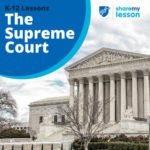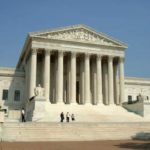“3 Must-Have Supreme Court Nomination Documents” looks at President Ronald Reagan’s appointment of Supreme Court Justice Antonin Scalia in 1986. Primary Source A outlines the suggested qualities of an ideal candidate for President Reagan to nominate to the Supreme Court. Primary Source B provides a Memo to the President from Peter J.
Wallison, Counsel to the President, in which Wallison provides background information with a few potential questions for both Justice Rehnquist and Judge Scalia. Primary Source C is a transcript from President Reagan’s August 9, 1986, Radio Talk on the appointment of the Supreme Court Justices. Each of these documents showcase the amount of thought and consideration the president must take when nominating a Supreme Court Justice.
Landmark Supreme Court Cases
When the stories of We the People become cases before the U.S. Supreme Court, and when those cases result in the opinions of the Court, history turns. The ways we think about and live under the Constitution are reflected in the Court’s interpretations in both their historical contexts and their legacies. Some cases — and the Court’s opinions in them — so profoundly alter our constitutional understandings that they can only rightly be called Landmark Cases, markers of where we have traveled as a nation. In this way, the Landmark Cases show us what we have tried, where we have been, and where we are — leaving We the People and future sessions of the Supreme Court to determine how we move forward toward a more perfect union.
Supreme Court Cases On Display
The purpose of this lesson is to have students working in groups of two or three focus of one historic Supreme Court case. Students will understand the process of bringing a case to the Supreme Court, read arguments and discover the importance of this third branch of government. Students will discover the changes these cases made in the lives of people. Then students can determine how the outcome may have affected their lives.
Use Constituting America’s Constitution Archives on U.S. Supreme Court Cases and Justices to support this lesson.
Landmark Supreme Court Cases
In a partnership with the National Constitution Center, Khan Academy talked to constitutional scholars about ten of the most significant Supreme Court cases in history. Teachers can use this lesson as a supplemental resource during their Supreme Court unit to show how constitutional scholars can debate the outcomes of Supreme Court cases, as well as the impact these cases have had on the United States.
Historic Supreme Court Cases
Students will learn about historic Supreme Court cases and the process of bringing a case to the Supreme Court. They will read arguments and discover the importance of this third branch of government. Students will discover the changes these cases made in the lives of people. From the knowledge they gain, students can determine how the outcome may have affected their lives.
U.S. Supreme Court Decisions and Justices Who Made Them
“Who cares what old people in black robes say?” As an educator you care. The challenge is how do you get your students excited about Article III of the Constitution. Constituting America has organized 90 Supreme Court cases of influential and history-changing decisions in its Constitution Archives. Need a judicial decision on what you are studying? Find it here. Need a Supreme Court ruling on a current event? Find it here. You get the picture. The material you seek is here. Your challenge, should you accept it, is make it come alive to your students.
The Supreme Court: Balancing the Branches

The nine, lifetime-appointed justices on the Supreme Court play a huge role in our lives through interpreting the application of laws passed by the United States Congress and state legislatures. The Share My Lesson team has curated a collection of free lesson plans and activities to support teachers in educating their students about the structure and role of the Supreme Court.
Landmark Supreme Court Case: Roe v. Wade
The Supreme Court has the power to interpret the Constitution. Its rulings on cases determine the meaning of laws and acts of Congress and the president. Knowing the key decisions of the Supreme Court and the precedents they set is vital in understanding the meaning of laws, how our country has changed over time, and the direction the country is currently headed. In this lesson students will examine the case of Roe v. Wade.
The Supreme Court: The Judicial Power of the United States

This lesson provides an introduction to the Supreme Court. Students will learn basic facts about the Supreme Court by examining the United States Constitution and one of the landmark cases decided by that court. The lesson is designed to help students understand how the Supreme Court operates.
The federal judiciary, which includes the Supreme Court as well as the district and circuit courts, is one of three branches of the federal government. The judiciary has played a key role in American history and remains a powerful voice in resolving contemporary controversies. The first governing document of this nation, the Articles of Confederation, gave Congress certain judicial powers, but did not establish a distinct federal court system.
2017 Supreme Court Nomination: Advising Senators Activity
Are you teaching about President Trump’s nomination of Judge Neil Gorsuch to the U.S. Supreme Court? Lead your students through an exploration of the process and have them take on a role as adviser to a senator in preparation for the Senate Judiciary Committee’s confirmation hearing.